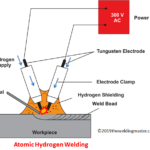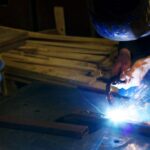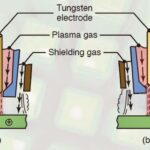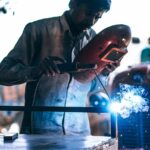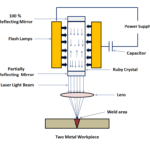Introduction:
Welding is one of the most Prominent joining processes used in almost all industries at every level, from conventional to non-conventional methods. Talking about the mechanism of welding, there are three primary mechanisms- Solid-state welding, Fusion welding, and Solid-liquid welding. Friction welding is a part of Solid-state welding in which both the workpiece remains in Solid-state and are joined together. This article will help you know friction welding in detail, talking about its working, types, applications, advantages, and disadvantages. So, let’s get started.
Definition of Friction Welding (FRW)
It is a solid-state welding in which the Friction force of the workpiece is used to generate heat and that heat joins the two metal pieces together. The heat generated by friction is so high that it is capable of melting metal pieces and letting them fuse together for joining.
History:
The Patent related to friction welding dates back to the turn of the century, with rotary welding being the oldest of all. It was W. Richter who patented the method of linear friction welding in 1924 in England and 1929 in Germany. The description of the process was vague and was not understood at that time. H. Klopstock patented the same process in USSR in 1924.
However, the first and foremost experiment related to the process took place in the Soviet Union in 1956 related to rotary welding. Senior machinist A.J. Chdikov then realized that the process is commercially viable and paved the way for its commercial use. The process was first introduced in the USA in 1960. Various big giants of the USA, including Rockwell International, American manufacturing foundry, and Caterpillar tractor company, developed the machine related to this process. The second process associated with friction welding, named friction stir welding (FSW), was patented and proved experimentally at the Welding society (TWI) in 1991. Today material for the research related to this joining process comes from various countries, including countries from continents Africa, Asia, Australia, Etc.
The Historical timeline related to the joining process, in brief, is as follows:
- 1924: The patent for linear friction welding filed in England and USSR
- 1929: The Patent for Linear friction welding filed in Germany
- 1956: First Experimental proof of friction welding and the start of commercial use
- 1960: Friction Welding arrived in the USA
- 1991: Patent and experimental proof of Friction stir welding
- 1991-till now: Advancement in the field of friction welding
Main Parts of Friction Welding:

Although there is no fixed configuration for this Joining process, we will introduce you to some of the essential components and their functions to help you understand the working of friction welding. The main parts are as follows:
1. Rotating Workpiece/Rotor
This Joining process has two workpieces; one is stationary and the other is rotating. The rotating workpiece is termed as Rotor.
2. Stationary Workpiece or Non-Rotating Part:
The workpiece that does not rotate is called a Stationary workpiece. During the welding process, this workpiece remains stationary.
3. Motor:
It is a component of this Joining process used to rotate the Rotor or one of the workpieces through the Belt drive.
4. Pressure Component:
This Component applies linear pressure on the rotating workpiece through the Stationary workpiece.
5. Belt Drive:
It is a component that is used to drive the rotor connected through the motor. The motor drives the Belt drive, which in turn drives the rotor.
Apart from the components mentioned above, we have several other components used but are not found on all the types of friction welding. They may include, Clamps, supporting, Adjustable backstops, Etc.
Also Read:
- What is MIG Welding? – Complete Explanation
- What is Shielded Metal Arc Welding ?- Complete Explanation
- What is Arc Welding – Definition, Types, Working, Advantages, and Disadvantages
Working Principle of FRW:
As told earlier, the friction welding process is based on the technique of the Solid-state welding process. The heat used to join the workpiece is generated through friction between the workpiece in relative motion. Hence, the name friction welding. This type of welding technique is used for metals and thermoplastics in various aviation and automotive applications. The standard ISO norm for this welding is EN ISO 15620:2019. This norm contains information related to some basic terms and definitions and a table of weldability of metals and alloys.
There is various joining process under this type, but all of them involves the same working principle, which is summarized as follows:
- Step 1: The faces of the workpiece that are going to be welded are brought together. One is attached to a motor and functions as a rotor, while the other is fixed.
- Step 2: The Rotor is then brought near the stationary workpiece and joined together physically. Hence, it makes the other one start rotating, which in turn cleans its surface.
- Step 3: Now, an axial force is applied on the stationary workpiece towards the rotor workpiece until enough heat is generated until Plastic deformation.
- Step 4: When the required temperature is reached, the rotor is stopped, and axial force increases to join the two workpieces, and a permanent joint formation occurs.
Since the process is quite complex, they are used only for those workpieces that can’t be welded with other welding processes.
For a Better Understanding of Friction Welding Watch the Video …
Important Terms:
A few important terms are to be known before going more into the joining process. The Important terms are as follows:
- Axial Force: Force that is applied parallel to the axis of rotation. It is also called thrust force.
- Burn-off length: Total loss of length during the friction process.
- Burn-off rate: It is the rate of shortening of the component during the friction process.
- External Braking: It is the braking component that is located externally and helps in reducing the rotational speed.
- Faying Surface: Surface of one component to be in contact with the surface of another component to form a Joint.
- Forge force: Force that is applied normally to the faying surface after relative motion is ceased.
- Forge phase: It is the interval time between the start and finish of the application of force.
- Forge time: it is the total time for which the forge force is applied to the components.
- Stick out: Distance through which one component sticks out from the fixture or chuck towards the other component.
- Weldment: Two or more components joined by welding.
Types of Friction Welding:
The Joining process is mainly divided into two types: Continuous Induce friction welding and Inertia friction Welding.
1. Continuous Induce Friction Welding:

In this Joining process, the rotor (or the rotating workpiece) is connected to a band brake. When the rotor rotates, it crosses its plastic limit temperature. The band brake applies pressure which tends to stop the rotor, while the second workpiece keeps on applying pressure on the rotor to form a single component. Hence, the name comes as continuous induced friction welding due to the constant application of axial pressure.
2. Inertia Friction Welding:

It consists of a rotating component connected to a flywheel, which is again connected to a shaft flywheel, driven by a motor. The working depends on the rotation of both the flywheel, where one gives motion to the other. When the process starts, the shaft flywheel rotates the other flywheel, thereby rotating the rotor. At the required time, it gets disconnected, and the motion of the rotor eventually comes to an end. During the entire motion, linear pressure is applied by the second workpiece on the rotor to perform welding.
In the above paragraphs, we have classified the process based on the mechanism of working. There are a few main friction welding techniques based on the material being used, primarily divided into metal techniques and Thermoplastic techniques.
Metal Techniques:
Few techniques are used to Weld metals, which we can’t weld through other Welding processes, which consist of the following:
1. Rotary Friction Welding:

It is a welding technique in which One workpiece is rotated, and another one is pressed down. The heat generated during the process causes two metals to weld together.
2. Linear Friction Welding:
It is a type of welding technique in which the rotating workpiece oscillates linearly instead of rotating.
3. Friction Stir Welding:

It is a welding technique that uses non-consumable tools to join two workpieces. The heat is generated between the workpieces and the tool and produces plastic deformation at the contact point and fuse them together to form a strong weld.
4. Friction Surfacing:
It is a process that is mainly derived from friction welding where we apply a coating of material to a substrate. The coating material rod is rotated and is joined with other substrates through Plastic deformation.
Thermoplastic Techniques:
Few techniques are used to Weld Thermoplastics, which can’t be welded through other Welding processes, which consist of the following:
1. Linear Vibration Welding:
In this type, the material comes in contact and is under pressure. An external vibrating force is applied to produce slip between the two perpendiculars to the direction of applied pressure.
2. Orbital Friction Welding:
Orbital friction welding is similar to spin welding but uses a more complex machine to produce an orbital motion in which the moving part rotates in a small circle, much smaller than the size of the joint as a whole.
Advantages of Friction Welding
This joining process act as an additional process for the material, which can’t be joined through other conventional and non-conventional welding processes. It serves a significant advantage which attracts few materials and conditions for which this process is used for Welding. The advantage of friction welding are as follows:
- The efficiency of the weld is high.
- It is an environment-friendly process without any smoke generation.
- The heat-affected zone is very Narrow. Hence, there is no change in properties for heat-sensitive material.
- It doesn’t require any filler material as the process uses friction to join two workpieces.
- The overall strength of Welding is most vital in most cases.
- Welding does not use any external source and is dependent on friction and plastic deformation properties. Hence, varieties of materials can be welded.
- We can achieve high Welding speed in this joining process
Disadvantages of Friction Welding
Apart from having advantages, the process has various disadvantages, which makes it unsuitable for various welding operations performed at different positions. The disadvantages of friction welding are as follows:
- The working mechanism allows it to be used mostly for circular cross-section bars, rotating, and making contact.
- Materials that are non-forgeable can’t be welded.
- The design of joints and the type of welding that can be performed is highly limited.
- Workpiece preparation is the most critical task.
- The cost of setup is very high.
Applications:
The first commercial use of friction welding started in the 1960s, with application in Industries, but due to the introduction of other conventional and non-conventional welding techniques that are superior to this process, the application is limited. However, because of the few unique advantages that this process provides apart from the other processes, it is still in use and is highly used in Industries to perform welding of materials that we can’t perform with the other techniques. Application of this process includes:
- Welding of circular components like Tubes, Pipes, and shafts.
- It is highly used in the automotive, aerospace, marine, and Oil Industries.
- Used to weld the pump shaft, which is a weld between stainless steel to the Carbon steels.
- The gear lever, axle tubes, connecting rods, Etc., are all-welded using this welding process.
- It is widely used in Electrical Industries to weld copper and aluminum wires.
- It is used for materials that can’t be welded using other available Welding techniques.
FAQs: Frequently Asked Questions
Q 1: What do you mean by forgeable and non-forgeable material?
Ans: Forgeable materials are material that can go under deformation by forging without cracking metal that can be formed. Non-forgeable material can’t undergo forging and have a low cracking temperature. The range of forging ability is defined by maximum forging temperature.
Q 2: When Friction welding is used as the primary welding process?
Ans: Most of the time, this type of Welding process is used as a secondary process and is used when any material cannot be welded through primary techniques. In round bars, we prefer this technique first as it is much faster and provides accurate Welding.



